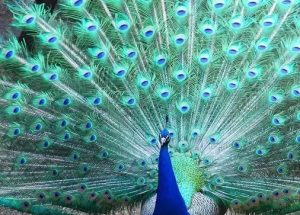
Peacocks, known for their extravagant plumage and graceful presence, have fascinated humans for centuries. These regal birds belong to the pheasant family and are native to South Asia.
The vibrant and iridescent colors of their feathers have earned them the reputation of being one of the most beautiful creatures on Earth.
Understanding the Peacock’s Plumage
Iridescence: Nature’s Finest Artistry
The shimmering beauty of a peacock’s feathers is a result of iridescence, a unique optical phenomenon where colors change with the angle of light. The microscopic structure of the feathers scatters light, creating a captivating display of vibrant colors that seem to shift as the peacock moves.
Elaborate Feathers: A Closer Look
The magnificent tail feathers, also known as the “train,” are the hallmark of a male peacock. Comprising elongated upper tail coverts, these feathers can reach up to six feet in length, far surpassing the size of the peacock’s body.
Peacock vs. Peahen Feathers: Sexual Dimorphism
The flamboyant plumage is specific to male peacocks, while peahens have more modest and cryptic colors to help them blend into their surroundings. This striking difference is an example of sexual dimorphism, where males and females of the same species exhibit distinct physical characteristics.
The Role of Spreading Feathers
Attracting a Mate: The Mating Ritual
The elaborate display of a peacock’s feathers plays a crucial role in courtship. During the breeding season, male peacocks put on a grand show by fanning out their feathers in a semicircular fan and rhythmically shaking them. This display serves as a signal to attract potential mates.
Communication: Speaking Through Plumage
Feather displays aren’t limited to courtship; peacocks also use them to communicate with each other. The intensity and extent of the feather display convey information about their mood and intentions.
Establishing Dominance: The Peacock’s Territory
In addition to attracting mates, peacocks use their majestic display to establish dominance and defend their territory. By showcasing their impressive plumage, they discourage potential rivals and assert their authority.
The Science Behind the Display
The Brain-Behavior Connection
The intricate display is orchestrated by the peacock’s brain. Studies have shown that certain areas of the brain are highly active during feather displays, indicating the complexity of this behavior.
Hormones and Pheromones: Nature’s Chemical Messengers
Hormones and pheromones play a vital role in triggering and coordinating the peacock’s display. These chemical messengers influence behavior and contribute to the timing of the feather display.
Evolutionary Significance of Peacock Feather Display
Natural Selection at Play
The evolution of the peacock’s elaborate plumage can be attributed to natural selection. The display acts as a signal of the peacock’s fitness, demonstrating its ability to survive despite carrying such a cumbersome trait.
The Handicap Principle: A Costly Display
The extravagant plumage comes at a cost, making the peacock more vulnerable to predators. However, this handicap serves as an honest signal to potential mates, indicating that the peacock’s genes are of high quality.
Human Influence on Peacock Feathers
Cultural Significance: Peacocks in Mythology and Art
Peacocks have played significant roles in various cultures and mythologies worldwide. Their feathers have been used in decorative arts, symbolizing beauty, immortality, and spirituality.
Conservation and Protection of Peacocks
Due to habitat destruction and illegal poaching, peacock populations face threats in the wild. Conservation efforts aim to protect these magnificent birds and preserve their habitats.
Peacock vs. Peahen: Comparing Behaviors
The Peahen’s Role in Mate Selection
While the peacock displays, the peahen carefully observes and evaluates potential mates before making her choice.
Nurturing the Offspring: A Shared Responsibility
Once the courtship is successful, both the peacock and peahen take an active role in raising their offspring, ensuring their survival.
The Mystery of the Dancing Peacock
Unraveling the Purpose of the Enchanting Dance
Aside from the feather display, peacocks also engage in mesmerizing dances during courtship, enhancing their chances of finding a suitable mate.
Peacock Facts You Might Not Know
Peacocks as National Symbols
Several countries have chosen the peacock as their national bird, celebrating its beauty and significance.
Peacock Enthusiasts: Peafowl as Pets
Peafowl enthusiasts around the world keep these birds as pets, relishing their captivating presence and melodious calls.
Conclusion
The peacock’s extravagant display of spreading feathers serves multiple purposes, from attracting mates and communicating with other peafowls to asserting dominance and surviving the forces of natural selection. Their iridescent plumage, mesmerizing dance, and rich symbolism in cultures make peacocks a true marvel of nature.
FAQs
Q1: Do all peacocks have colorful plumage?
No, only male peacocks exhibit the vibrant and colorful plumage, while female peahens have more subdued colors.
Q2: What is the lifespan of a peacock?
In the wild, peacocks can live for about 15 to 20 years, while in captivity, they may live up to 25 years.
Q3: Can peacocks fly despite their elaborate feathers?
Yes, despite their long and elaborate feathers, peacocks can fly for short distances when escaping predators or roosting in trees.
Q4: How do peacocks take care of their chicks?
Both the male peacock and female peahen play an active role in raising and protecting their chicks.
Q5: Are white peacocks a separate species?
No, white peacocks are not a separate species; they are a color variation of the Indian peafowl, known as leucistic peafowls.